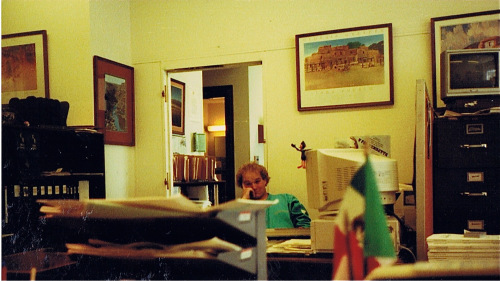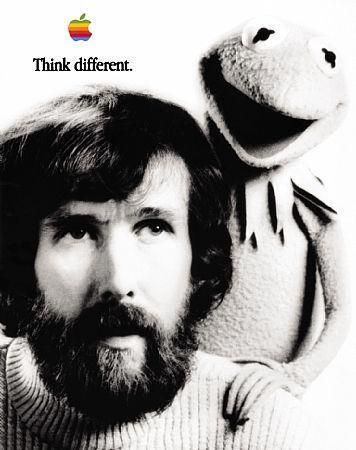Brian Jay Jones's Blog, page 22
November 21, 2011
In Media Res (1991 Edition)
Speaking of workspaces . . .
I opened my e-mail this morning to find a photograph (seen below) from my pal Marron, with whom I shared an office in my first years on Capitol Hill in the early 1990s. She and I (and usually two, sometimes three, others) worked in this office in the U.S. Senate Dirksen Building — a building that had all the charm of a 1960s-era high school — from 1990 until about 1995. It was here that we first learned that airplanes were on their way to the Middle East for the opening volleys of first Iraq war, where she and I answered phones over Columbus Day weekend during the infamous Clarence Thomas hearings, and where we generally worked long into the night when the Senate was in session. Marron and I could also get into quite a bit of trouble together; we took great delight in pranking our fellow staffers, and each other. (Marron once crashed our office phone system by forwarding every phone in the office to my direct line.)
Anyway, if you think from watching television or movies that the life of a Hill staffer is glamorous, and that we all work at enormous oak desks in offices lined with gigantic bookshelves crammed with leather-bound books and framed prints of the Founding Fathers on the wall, well . . . not so much. Here's me in my workspace in 1991 or so, as photographed by Marron from her desk across from me (you can see her own inbox in the foreground):
(Click on it if you want to embiggen it and enjoy me in all my twentysomething glory.)
Yeah, that's me with a head full of hair. Shut up. Given the way I'm dressed, the Senate was likely in an extended recess, when we didn't have to wear our usual suits and could come in a bit more casually dressed.
Sitting on the desk in front of me is one of those gigantic old IBM desktop computers. Back in the early 1990s, the only people in our office who had desktops were the low folks on the totem pole — and that's because we were using them to draft responses to constituent mail, which we could then save onto an inner-office network, where anyone with a desktop could pull them up. And let me tell you, we worked those things hard, responding to about 10,000 pieces of mail each month. (And as Marron reminded me in her e-mail accompanying this photo, it wasn't too long after this picture was taken that my computer monitor actually caught fire.)
All other office business — including a rudimentary e-mail system — was carried out on computers we called The DeeGees — old green-screened Data General computers, hooked into a central system that made it possible to share files and send messages. Mine was on the desk's return, just behind the clunky IBM. (If you think your computer currently takes up too much space on your desk, try having two.)
The bookshelf to the left in the photo was my filing system — and you can see that, even then, I was still a black binder kinda guy. There was an old dot-matrix printer in the space just behind the bookshelf, where our assistant press secretary would print out wire stories once each day, making a loud zzzt zzzt zzt! for about 30 minutes.
The television you see — which we used to monitor the Senate floor — wasn't mine or Marron's; it belonged to another staffer we all called Joe T, who had one of the two desks next to the window. And on the wall? Not Founding Fathers, but Georgia O'Keeffe prints (the one behind my desk was a painting of the Taos Pueblo) and framed photos of New Mexico scenery. And it looks like I also had a small promo poster for Alan Moore's V for Vendetta taped to the wall just above my DeeGee.
Finally, it appears there's a pile of papers on the desk in front of me. Some things never change. Apart from the hair, of course.








November 17, 2011
In Media Res
It's probably due to the upcoming premiere of the brand spanking new movie The Muppets (coming to a theater near you on November 23), but over the past few days I've been asked more and more, "How's the book coming?"
The short answer: really well. I recently finished writing extensively about The Muppet Show, which puts me about two-thirds of the way through. But there's still a lot more to go — that Jim Henson was a busy and productive guy — and as I make the turn into the final third of the book, my desk is officially a mess. And to respond to some of the other questions I've received, here's what my workspace presently looks like:

Whatta mess.
It's a bit blurry — I took it with my phone — so let me guide you around. On the wall behind my chair is the gigantic white board I use to draw up the timeline for the chapter I'm working on, along with any random notes (at the moment, there's a scribbled address for the long-gone Muppet Stuff store in New York City).
On top of the desk (which is actually just two old tables pushed together, with a filing cabinet shoved into the open corner) is an assortment of black binders (filled with transcripts of interviews, notes, and newspaper articles) along with several journals and scattered Post-It notes. You might also see the corner of a copy of Christopher Finch's fantastic Jim Henson: The Works peeking out, as well as Caroll Spinney's The Wisdom of Big Bird. And that piece of red striped paper is actually part of my Bible for this project: a well-thumbed and marked-up photocopy of Jim's Red Book, generously provided by the Henson family.
What else? On top of the filing cabinet in the lower left hand corner are all four volumes of an 1862 edition of The Life and Letters of Washington Irving—still a fellow close to my heart—and because I believe you should always have your subject looking over your shoulder as you write, the mantlepiece behind me (yeah, it's a real working fireplace) sports a framed photo of Jim Henson lounging across a set of theater seats with his arm draped around Kermit.*
What's next? During the last week of November, I'll be interviewing not one, not two, not even four, but five more Really Neat People, and I'm producing chapters regularly, which keeps my editor happy. And while I try to spend most of my days sitting right there in that leather chair you see above, I have to admit I'll be spending several hours out of it next Wednesday. I'll be at The Muppets, you know.
Thanks, everyone, for their questions and enthusiasm!
* Just for fun, see if you can also spot a 1960s-era Batmobile and the Mach 5 among the mess, as well as a Jim Henson action figure, strumming a banjo.








November 11, 2011
RIP Bil Keane (1922-2011)
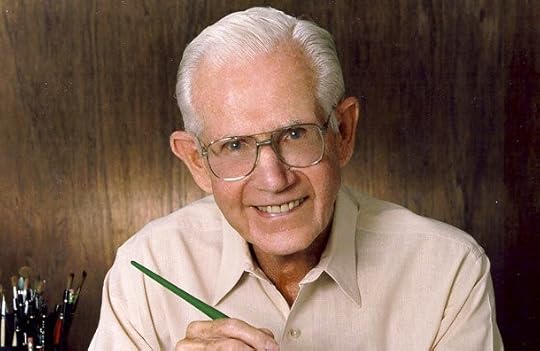 See that kindly face over there? You've probably seen his name and work a thousand times in your life, but you likely don't know the face. That's Bil Keane, who brought the single-panel comic Family Circus to your local newspaper pretty much every day since 1960. Keane died earlier this week at age 89, and you can read all about him in The Washington Post obituary right here.
See that kindly face over there? You've probably seen his name and work a thousand times in your life, but you likely don't know the face. That's Bil Keane, who brought the single-panel comic Family Circus to your local newspaper pretty much every day since 1960. Keane died earlier this week at age 89, and you can read all about him in The Washington Post obituary right here.
While I was never a hard-core Family Circus fan in the way I was absolutely devoted to Charles Schulz's Peanuts, Keane's strip was one of those that my entire family read. In particular, we loved the paperback book collections. Visiting our cousins in Kansas usually meant getting an armful of new Family Circus paperbacks to take along on the car ride — and when we got there, we would ransack our cousins' own collection, trading paperbacks back and forth until, between us, we'd read them all. They were a quick and easy read, drawn in Keane's accessible style, with punchlines that even a seven-year-old could understand. I liked the sequences featuring the ghosts "Not Me!" and "Ida Know!" (our Mom would take those jokes and run with them, in fact) while my brother loved the panels that followed characters with a dotted line as they made their way to school, a garage sale, or around the back yard.
People often criticized Keane's cartoon for being too dated, too lost in an idealized past or family structure. For that reason, it was an easy target for satire — but no one laughed harder at the parodies of the strip than Keane himself. Keane, in fact, was much funnier than he let on in his strip; he would apparently knock 'em dead each year as the host of National Cartoonists Society's annual banquet. But his own inherent sweetness was the real strength behind Family Circus—and Keane also made it look way too easy. "But allow me to point out the obvious," said Dilbert's Scott Adams. "If other cartoonists could make a family-oriented comic that was as popular as 'Family Circus,' they would have done it."
No one did, and likely never will do it as well as Bil Keane.








November 1, 2011
Autumn Leaves
It's fall, the publishing industry is back in full swing, and that means there are plenty of great new books to choose from. Let's see. . .
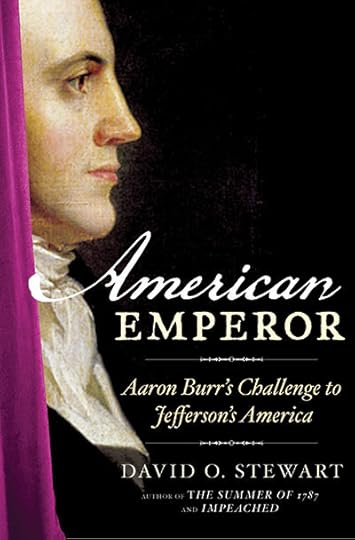 Over the weekend, I had the pleasure of attending the book launch for American Emperor: Aaron Burr's Challenge to Jefferson's America
Over the weekend, I had the pleasure of attending the book launch for American Emperor: Aaron Burr's Challenge to Jefferson's America , by my colleague David O. Stewart. Stewart views Burr's tale as both an adventure story and a political/legal thriller, and why not? Imagine a novel in which a sitting Vice President is charged for murder in two states, plans an elaborate military coup to overthrow the U.S. government (and have himself installed as the head of the new upstart government installed in its place), is indicted for treason, and is put on trial — and acquitted! — before the Chief Justice of the United States. A tale too unbelievable to be true? You bet — and yet it is. Stewart's book is available now—and getting spectacular reviews—so go get it (and look for a cameo appearance by Washington Irving, who made sure he had a good seat in the courthouse every day of Burr's trial in Richmond).
, by my colleague David O. Stewart. Stewart views Burr's tale as both an adventure story and a political/legal thriller, and why not? Imagine a novel in which a sitting Vice President is charged for murder in two states, plans an elaborate military coup to overthrow the U.S. government (and have himself installed as the head of the new upstart government installed in its place), is indicted for treason, and is put on trial — and acquitted! — before the Chief Justice of the United States. A tale too unbelievable to be true? You bet — and yet it is. Stewart's book is available now—and getting spectacular reviews—so go get it (and look for a cameo appearance by Washington Irving, who made sure he had a good seat in the courthouse every day of Burr's trial in Richmond).
 The book currently sitting on my nightstand is Walter Issacson's biography Steve Jobs
The book currently sitting on my nightstand is Walter Issacson's biography Steve Jobs , which is already kicking ass and taking names on numerous bestseller lists. Those of us who were keeping tabs on Issacson's book for the past year (and who rolled our eyes when it was rumored, probably falsely, that the book was going to called either The Book of Jobs or iJobs) watched with interest as it was updated and revised after the manuscript was already completed to reflect Jobs's resignation from Apple due to health reasons — and then revised again immediately following his death. That gives Issacson's book the wonderful weight of immediacy—though it's not like most us weren't chomping at the bit to get our hands on this one anyway.
, which is already kicking ass and taking names on numerous bestseller lists. Those of us who were keeping tabs on Issacson's book for the past year (and who rolled our eyes when it was rumored, probably falsely, that the book was going to called either The Book of Jobs or iJobs) watched with interest as it was updated and revised after the manuscript was already completed to reflect Jobs's resignation from Apple due to health reasons — and then revised again immediately following his death. That gives Issacson's book the wonderful weight of immediacy—though it's not like most us weren't chomping at the bit to get our hands on this one anyway.
[image error]Coming up next week is the long-awaited And So It Goes: Kurt Vonnegut: A Life by my pal (and fellow BIO member) Charles J. Shields, who pulls back the curtain on the enigmatic writer whose Slaughterhouse Five has been picked up by countless high school students who thought they were reading a horror novel. Ahem.
by my pal (and fellow BIO member) Charles J. Shields, who pulls back the curtain on the enigmatic writer whose Slaughterhouse Five has been picked up by countless high school students who thought they were reading a horror novel. Ahem.
I'm anxious to get my mitts on this one as well, though I'll admit to having some inside information: namely, I know how hard Shields worked not only on the book itself, but on getting Vonnegut to allow him to write the story in the first place. You can read that story and more over on Shields' way-cool blog Writing Kurt Vonnegut, where you'll learn all about his adventures as Vonnegut's biographer — as well as beer, kid's TV, and writing in general. Go. Now.
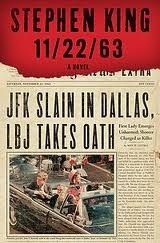 Over the past decade or so, I've largely given up fiction—but I'm still a sucker for Stephen King (yeah, guh head, make the face!) and I've gotta admit to being psyched for his newest, the massive, 960-page 11/22/63: A Novel[image error]. I had to fling aside the review in today's Washington Post, which seemed too eager to commit the major foul of Giving Too Much Away.
Over the past decade or so, I've largely given up fiction—but I'm still a sucker for Stephen King (yeah, guh head, make the face!) and I've gotta admit to being psyched for his newest, the massive, 960-page 11/22/63: A Novel[image error]. I had to fling aside the review in today's Washington Post, which seemed too eager to commit the major foul of Giving Too Much Away.
And finally, I just read this afternoon that the fourth — but not yet final! — book in Robert A. Caro's biography of Lyndon Johnson comes out next May.
What are you looking forward to reading this fall? You don't have to post it here, just talk amongst yuhselves.
 [image error]
[image error]



 [image error]
[image error]

October 19, 2011
Remembering Kay
If you're lucky, every once in a while someone comes into your life who makes your life better and more interesting just by being so wonderfully, unfailingly, unapologetically human.
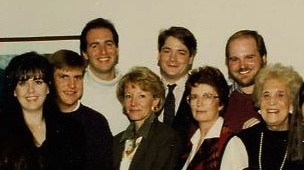
Kay Davies, center, along with some of the others whose lives she touched -- including yours truly, in the back row on the right.
Kay Davies was that way for me. She was my boss for most of my twenties, when she came into the office of Senator Domenici as the new Legislative Director in late 1990. Kay had worked for the Senator before, in the early 1970s, and had then gone on to a distinguished career working in the State Department for President Reagan—her favorite story, and one she re-enacted for us frequently, was striding into her empty State Department office with her boxes under her arm on the morning Reagan was sworn in, and answering the ringing telephone only to be told that the Iranian hostages were being released at that very moment.
Kay was loud and brassy and opinionated, and when she walked into our little suite of offices in 1990, she scared the hell out of almost all of us. But she was also wonderfully open minded—and when she came into an organization where most of its senior staff had moved on to other jobs after the 1990 election, Kay did something that, knowing her now, was typical of her: she put her faith in all of us snot-nosed twentysomethings, letting us slide into those empty chairs and take on the responsibilities of senior legislative staffers.
Some might disagree, but I'd say it was a good investment—and over the next seven years, I learned a lot. Almost immediately, Kay and I were working together, poring over a proposed revision to the sacred Civil Rights Act. It was an important but highly technical change, steeped in obscure legal precedent—and since neither of us had a legal background, we would sit in her cramped office reading through policy papers, calling the Justice Department on speakerphone, arguing over language, and drafting statements (she would always insist on typing, pounding away on her computer keyboard as I paced the narrow room behind her talking my way through a paragraph). She would lose her patience on the phone when she thought White House staffers were trying to brush her off, snapping a pencil angrily in her hand with an audible POW! And always, always there was a cigarette burning, slowly filling her office with a gauzy gray-blue haze.
She could manage a meeting like no one else. She always came prepared, usually with an accordion folder bursting open under her arm, and she had little time or patience for pat answers—she would call bullshit on anyone the moment she caught the first whiff of it and ask them firmly to start over and try again. And she was smart; she was the first person I ever met who could read through a lengthy document and summarize it in four sentences or less—an unbelievably important skill in politics—and she could always come up with a really good, real-life example to illustrate her point. She was passionate about policy and politics, her voice rising higher and louder and she made her case. But she wasn't extreme in either direction; she was mostly merely practical—and you if would walk by her office when she had the Senate floor playing on her small television, you would hear her griping at any grandstanding, regardless of which side of the aisle was carrying on.
She was tough and gruff and worked us hard — but at the end of each work week, she ensured that the office fridge was filled with beer and soda. At 6:00 p.m. on Fridays, she would crack open a beer (it was always Miller Lite), light up a cigarette, and sit down to gossip and laugh with the rest of us. In short, she was a dynamo, a whirlwind, and I loved her. I think we all did.
She was the first person I'd met who wasn't afraid to be herself. She wore brightly colored scarves, carried huge but expensive handbags, and never held back her opinion. When she was in a hurry, she'd take these long, pounding steps that practically broadcast her mood. She loved calamari, but she loved pizza even more. She could laugh loud, and cuss even louder. Yet, even with her famously potty mouth, the worst thing she would ever call anyone was "dodo bird"—and if you made the dodo bird list, believe me, brother, you were in big trouble.
She was a mentor to me not only in politics, policy, and the world in general, but she also shaped the way I wrote. While I always marveled at her ability to write these concise policy analyses, she never considered herself a great writer—she called her style 'bang bang bang'—but she was a fantastically brutal editor. She had no patience for overly purple prose (she'd let some creep in—it was politics, after all) and she was a strict adherent to Strunk & White's directive to "omit meaningless words," something I'd always struggled with. Consequently, my speeches would come back with phrases—sometimes paragraphs—crossed out so stridently that her black pen left divots in the page. Other times, the intercom on my desk would ring and she'd say—loudly, of course—"Beautiful. I sent it in." Those moments made my day.
I still have a tendency to lean purple—but because of Kay and her black pen, I quickly (and early on) overcame the so-called Golden Word syndrome, where I was convinced every word on the page was beautiful and perfect. I didn't always like it when some of the bits I had slaved over or was proud of because I thought they were so clever came back with a black slash through them. But I trusted her judgment and I could always see her point—a mentality that proved invaluable the first time I ever had a completed manuscript in front of a book editor. (An entire chapter had to go? Fine.)
A little more than a decade ago, Kay was diagnosed with cancer. The outlook even then was bleak—she was always being told she had less than a year to live. Yet, she kept hanging on, never losing her sense of humor, her sense of self, or her sense of her own place in the universe. She made it to my wedding—a sweltering hot July day—walking through the woods in Williamsburg by herself. We traded e-mails regularly, and I would stop by every once in a while—though not as much as I would have liked—to talk with her, move furniture, or help her with her "goddamn computer."
She loved history and biography—she was a big fan of David McCullough and read anything on the Romanovs—and collected and framed historic prints and documents (she had, for example, a commission for an army officer signed by James Madison). We would talk for hours about books and history—her knowledge of the Civil War could be staggering—and she was genuinely proud of me when my Washington Irving biography was published in 2008. It couldn't have happened without her—and I told her so. In fact, I told her everything she had done for me, and how much I loved her. It embarrassed her a bit—she was defiantly unsentimental (I don't even have a photo of us together!)—but I meant every word.
Over the last few months, as Kay's health deteriorated, she refused to let anyone feel sorry for her, and rebuked suggestions that she retire to a hospice. She wanted to be at home, with her books and her piano and her cat. I went to visit her several times, and she didn't appear to be dying so much as she looked to be simply fading away, as if she were being slowly erased from within. Her voice, once so loud and firm, was quiet and higher-pitched, from the cancer pressing against her vocal cords. But there was still a bit of fire behind her eyes as she laughed at familiar stories or discussed something she'd read in the newspaper that morning. She was, as my pal Marron put it, "grit and determination all the way to the end."
Kay passed away earlier this week. She was at home, just as she wanted. And typically, she insisted on no service, no obituary, and no fuss—very much like her. But I wanted to make sure she didn't pass away without the universe taking just a bit of notice of an extraordinary woman who was once so alive, so loud, and so human—and who meant so very much to me. I'll miss her. A lot.


 [image error]
[image error]

 [image error]
[image error]
[image error]
[image error]
October 15, 2011
Washington Irving, His Kith and Kindle…
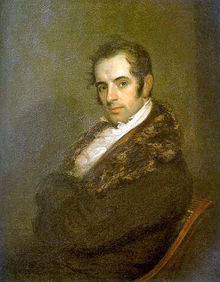 Once again, when I wasn't looking, Washington Irving went galloping into yet another format. It's now available as an e-book in the Kindle format—so you can read it on your iPad, so long as you have the Kindle app—and you can download it for a mere $9.99 right here
Once again, when I wasn't looking, Washington Irving went galloping into yet another format. It's now available as an e-book in the Kindle format—so you can read it on your iPad, so long as you have the Kindle app—and you can download it for a mere $9.99 right here .
.
If you're one of those folks like me who still lives the analog life and prefers a physical book you can hold in your hands, the paperback version will be available on November 15.




 [image error]
[image error]
[image error]
[image error]
[image error]
[image error]
October 6, 2011
Lost Genius
October 4, 2011
A Sixteenth Century Sid Vicious…
 My review of Andrew Graham-Dixon's new biography Caravaggio: A Life Sacred and Profane is the lead review over at the Washington Independent Review of Books, at least for today. Go have a look, if you want. Better yet, read Graham-Dixon's book.
My review of Andrew Graham-Dixon's new biography Caravaggio: A Life Sacred and Profane is the lead review over at the Washington Independent Review of Books, at least for today. Go have a look, if you want. Better yet, read Graham-Dixon's book.








September 24, 2011
Celebrate 75 Years of Making The World "A Bit Better For Having Been Here"
September 8, 2011
A Sure Sign Of Fall
School must be back in session, because the terms "cliff notes legend of sleepy hollow" are driving people here in droves.
It's not Cliff's Notes, but I did talk a bit about Irving's story right here. But really, just go read Irving's story. It's short (Irving's called the Father of the American short story for a reason). And if you base your paper on the Johnny Depp movie, you're in big trouble. Just sayin'.









